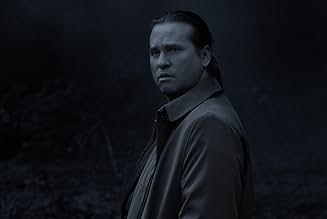Um escritor de horror que visita uma pequena cidade em uma turnê de livros é apanhado em um mistério de assassinato envolvendo uma jovem garota. Naquela noite de sonho, ele é abordado por um... Ler tudoUm escritor de horror que visita uma pequena cidade em uma turnê de livros é apanhado em um mistério de assassinato envolvendo uma jovem garota. Naquela noite de sonho, ele é abordado por um jovem fantasma misterioso chamado V.Um escritor de horror que visita uma pequena cidade em uma turnê de livros é apanhado em um mistério de assassinato envolvendo uma jovem garota. Naquela noite de sonho, ele é abordado por um jovem fantasma misterioso chamado V.
- Prêmios
- 2 indicações no total
Enredo
Você sabia?
- CuriosidadesDirector Francis Ford Coppola had originally intended the film as a type of "live editing" experiment using groundbreaking digital editing technology. Coppola intended to act as a sort of conductor during every screening of the film, lengthening or shortening scenes and even changing plot elements depending on the audience response. This caused long delays in the film's release and ultimately proved impractical, forcing Coppola to do a locked edit of the film, integrating elements from all various permutations of the story.
- Erros de gravaçãoWhen Hall Baltimore first goes to the hotel in the dream he orders just a beer. The beer is set in front of him and has a large head of foam. In the next scene the foam is gone. When the scene resumes the foam is back.
- Citações
[first lines]
Narrator: There was, once upon a time, a town not far from a big city. A road ran through, but there were only a few businesses. A coffee shop, a hardware store, a sheriff's office. And all kinds of people. Vagrants, run away teens, religious fanatics, retired seniors who, well, it was a town of those who wanted to be left alone. And so they were.
- ConexõesEdited into B'Twixt Now and Sunrise (2022)
Coppola has said in interviews that he's only making "personal" films from now on - maybe too personal. While there are elements in this film that show the master has not lost his touch, this film borders on the incomprehensible. Is it a comedy? A horror film? A psychological drama? A fantasy? Your guess is as good as mine - and, apparently, the cast's, as three participants in the film in attendance said as much in the Q&A that followed the screening. Actors Bruce Miroglio, Anthony Fusco, and Don Novello all had the same reaction after screening the film (only their second opportunity.) First, it was nothing at all like the film they saw a few months ago and Coppola was obviously still tinkering with it. Second, it was a helluva lot funnier than they remembered it.
Confusion maybe the theme of the film, but should that confusion have extended to the cast and, ultimately, the audience? One of the things the audience was confused about was that it was a 3-D film. Everyone eagerly played with the glasses until an announcement was made that there were only two short sequences in 3-D, and that it would be clear when those times were. That still didn't stop people from flipping the glasses on and off in a futile attempt to add some dimension to the film.
Coppola's choice to use 3-D does say something, though. Consider his contemporary - Martin Scorsese. Scorsese embraced the technology, used it to great effect to enhance his storytelling in "Hugo," and foresees using the process for all of his future projects. (We'll see.) How does Coppola use it? As a gimmick. An effective gimmick, but a gimmick none the less. Scorsese used it to draw you into the world of "Hugo." Coppola's use actually, and purposely, takes you out of his. Interestingly, only one of the two sequences was filmed using a 3-D camera. The second was added in post-production.
It really wasn't necessary, as the look of the film is one of its assets. Visually entrancing, and wonderfully atmospheric, the film has a cinematic look unlike anything else Coppola has done - even "Dracula." As for the cast, Val Kilmer giver a lead performance that almost redeems him from the trainwreck that is "The Fourth Dimension." I could have done without his umpteenth Brando impersonation, though. Uniformly fine work from the supporting cast helps. It's always good to have Bruce Dern back on screen portraying one of his "slightly-off" characters.
The script is the film's Achilles Heel, if Coppola even had one. I don't need every element of a story to be spoon-fed to me, but give me something to chew on, please. "Twixt" leaves too many threads dangling from the seams that are obviously fraying in this film. The parts are all there, they're just waiting to be sewn together in a much better fashion. Its ending is abrupt and confusing. As Miroglio said when responding to an audience member's comment that he really didn't know what happened at the end, "Francis' response would probably be – 'GOOD!'" Maybe for him, but not for an audience. Coppola says he got the idea for the film from a dream of his. Coppola's turned his dream into an audience's nightmare. Does he even care?
www.worstshowontheweb.com
- soncoman
- 28 de abr. de 2012
- Link permanente
Principais escolhas
- How long is Twixt?Fornecido pela Alexa
Detalhes
- Data de lançamento
- País de origem
- Central de atendimento oficial
- Idioma
- Também conhecido como
- Twixt
- Locações de filme
- Aetna Springs, Pope Valley, Califórnia, EUA(Chickering hotel)
- Empresa de produção
- Consulte mais créditos da empresa na IMDbPro
Bilheteria
- Orçamento
- US$ 7.000.000 (estimativa)
- Faturamento bruto mundial
- US$ 647.839
- Tempo de duração1 hora 28 minutos
- Cor
- Proporção
- 1.85 : 1
Contribua para esta página




































